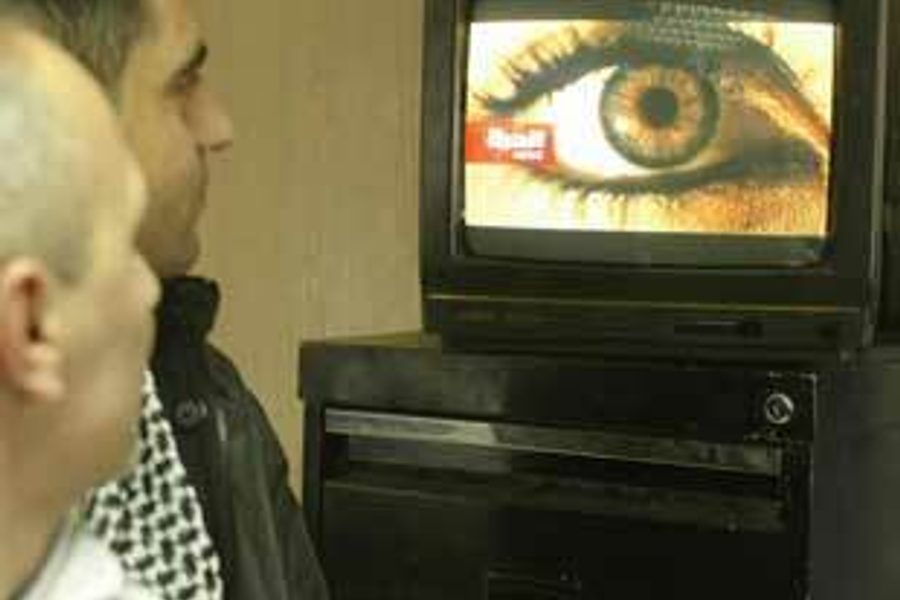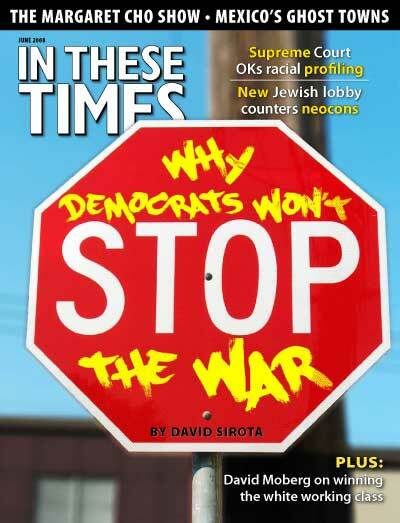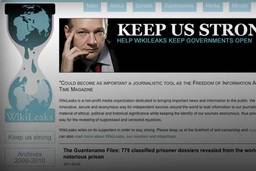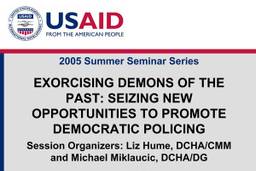No Strings Attached?
How U.S. funding of the world press corps may be buying influence
Jeremy Bigwood

Domestic propaganda campaigns like the “Pentagon Pundits” fiasco have been exposed and decried. Mainstream media outlets hired high-ranking military officers to provide “analysis” about the war in Iraq. Turns out they had ties to military contractors with a vested interest in continuing the war.
Below the radar, another journalism scandal is brewing: the U.S. government is secretly funding foreign news outlets and journalists. Government bodies – including the State Department, the Department of Defense, the U.S. Agency for International Development (USAID), the National Endowment for Democracy (NED), the Broadcasting Board of Governors (BBG) and the U.S. Institute for Peace (USIP) – support “media development” in more than 70 countries. In These Times has found that these programs include funding hundreds of foreign nongovernmental organizations (NGOs), journalists, policy-makers, journalist associations, media outlets, training institutes and academic journalism faculties. Grant sizes can range from a few thousand to millions of dollars.
“The bottom line is that we are teaching the mechanics of journalism, whether it be print, television or radio,” USAID spokesman Paul Koscak says. “How to do a story, how to write with balance … all of those types of things that you would expect in a professional piece that is published.”
But some people, especially those outside the United States, see it differently.
“We think that the real issues here are the foreign policy objectives behind these media development programs,” says a high-level Venezuelan diplomat who asked not to be identified. “When the objective is regime change, these programs have proven to be instruments for the destabilization of democratically elected governments that the United States doesn’t support.”
Isabel MacDonald, communications director at Fairness and Accuracy in Reporting (FAIR), a New York-based media watchdog nonprofit, is also critical. “This is a system that, despite its professed adherence to norms of objectivity, has often worked against real democracy,” she says, “by stifling dissent and helping the U.S. government spread misinformation serviceable to U.S. foreign policy goals.”
Show me the agency
Measuring the size and scope of independent media development is difficult because similar programs exist under different rubrics. Some agencies consider “media development” to be its own field, while other agencies categorize it under “public diplomacy” or “psychological operations.” That makes it hard to figure out how much money goes into these programs.
In December 2007, the Center for International Media Assistance (CIMA) – a State Department-funded office at the National Endowment for Democracy (NED) – reported that in 2006, USAID doled out almost $53 million for foreign media development activities. According to the CIMA study, the State Department spent an estimated $15 million on such programs. NED’s budget for media projects was an additional $11 million. And the small Washington, D.C.-based U.S. Institute for Peace may have contributed up to $1.4 million more, according to the report, which did not examine Defense Department or CIA media funding.
The U.S. government is by far the largest funder of media development in the world, giving more than $82 million in 2006 – not counting money from the Pentagon, the CIA or U.S. embassies in recipient countries. To complicate matters, many foreign NGOs and journalists receive media development funding from more than one U.S. government source. Some receive funding from various U.S. subcontractors and “independent international nonprofit organizations,” while others receive money directly from the U.S. embassy in their country.
Three foreign journalists who receive U.S. media development funding told In These Times that such gifts do not affect their behavior or alter their reporting. And they deny that they practice self-censorship. None, however, would say this on the record.
Gustavo Guzmán, a former journalist and now Bolivian ambassador to the United States, says, “A journalist who receives such gifts is no longer a journalist, but becomes a mercenary.”
A twisted history
The U.S. government’s funding of foreign media has a long history. During the mid-’70s, in the aftermath of Watergate, two congressional investigations – the Church and Pike committees, after Sen. Frank Church (D-Idaho) and Rep. Otis Pike (D-N.Y.) – delved into covert U.S. government activities in other countries. They confirmed that, apart from CIA-funded journalists (both foreign and American), the U.S. government also subsidized foreign print media, radio and television outlets – something the Soviets were also doing. For instance, Encounter, an anti-communist literary magazine published in England from 1953 to 1990, was revealed to be a CIA operation in 1967. And, as is the case today, benign-sounding organizations, such as the Congress for Cultural Freedom, have also been CIA fronts.
Congressional investigations found that clandestine U.S. funding of foreign media often played a decisive role abroad, but nowhere more so than in Chile in the early ’70s.
“The CIA’s major propaganda operation, through the opposition newspaper El Mercurio, probably contributed most directly to the bloody overthrow of the Allende government and Chile’s democracy,” says Peter Kornbluh, senior analyst at the National Security Archive, an independent nongovernmental research institute.
In These Times asked the agency if it still funds foreign journalists. CIA Spokesman Paul Gimigliano responded, “The CIA does not, as a matter of course, publicly deny or confirm these kinds of allegations.”
Enemies of the State Department?
On Aug. 19, 2002, the U.S. Embassy in Caracas, Venezuela, sent a cable to Washington. It read:
“We expect Mr. Lacayo’s participation as an IV grantee to be directly reflected in his reporting on political and international topics. As he moves upward in his career, our improved ties with him would mean a potentially important friend in positions of editorial influence.” [Editor’s Note: Mr. Lacayo’s name has been changed to protect his identity.]
The State Department had chosen the Venezuelan journalist to visit the U.S. under what is known as an IV grant – a cultural exchange program started in 1961. Last year, the department brought some 467 journalists to the United States at a cost of about $10 million, according to a State Department official who requested anonymity.
FAIR’s MacDonald says that the “visits serve to build ties between the visiting foreign journalists and institutions that … are extremely uncritical of U.S. foreign policy and the corporate interests it serves.”
The State Department funds media development through several of its bureaus, including the Bureau of Educational and Cultural Affairs, Bureau of Intelligence and Research (INR), and the Bureau of Democracy, Human Rights, and Labor (DRL), as well as through its regional bureaus and embassies worldwide. It also funds foreign journalists through another section called the Office of Public Diplomacy and Public Affairs. Most importantly, the State Department usually decides where other agencies, such as USAID and NED, should invest their media development funds.
(The State Department did not respond to In These Times’ requests for information about its media development budget, but the 2007 CIMA study shows that in 2006, DRL, for instance, received almost $12 million for media development alone.)
The case of Bolivia is a revealing example of a country in which the United States has been funding media development. According to DRL’s website, the bureau sponsored 15 workshops in Bolivia on freedom of the press and expression in 2006. “The country’s journalists and journalism students discussed professional ethics, good reporting practices and the media’s role in a democracy,” the site says. “These programs were sent out to 200 radio stations in remote areas throughout the country.”
In 2006, Bolivia elected Evo Morales, its first indigenous president, whose rise to power the U.S. government and Bolivia’s mainstream press has repeatedly tried to impede. Morales and his supporters allege that the U.S. government is backing a separatist movement in Bolivia’s gas-rich eastern states, and they allege that part of that backing involves media development meetings, according to journalist and former presidential spokesperson Alex Contreras. USAID’s Koscak denies the charge.
This is the BBG
The Broadcasting Board of Governors (BBG), is most famous as the funder of the Voice of America. According to its website, BBG is “responsible for all U.S. government and government-sponsored, non-military, international broadcasting” that brings “news and information to people around the world in 60 languages.”
In 1999, BBG became an independent federal agency. By 2006 it received a $650 million budget, according to CIMA estimates, with about $1.5 million earmarked for media development to train journalists in Argentina, Bolivia, Kenya, Mozambique, Nigeria and Pakistan.
Besides Voice of America, BBG also runs several other radio and TV stations. Alhurra television, based in Springfield, Va., “is a commercial-free Arabic-language satellite television network for the Middle East, devoted primarily to news and information,” according to its website. Alhurra, which is Arabic for “the free one,” has been described by the Washington Post as “the U.S. government’s largest and most expensive effort to sway foreign opinion over the airwaves since the creation of Voice of America in 1942.”
BBG also funds Radio Sawa (for Arab youth, with streaming to Egypt, the Gulf, Iraq, Lebanon, the Levant, Morocco and Sudan), Radio Farda (to Iran) and Radio Free Asia (regional programming in Asia). BBG also supports broadcasts to Cuba through Radio and TV Mart’, which will amount to almost $39 million this year, according to the Foreign Operations Congressional Budget Justification for fiscal year 2008.
Pentagon PR
The Department of Defense (DOD) refused to speak to In These Times about its media development programs. According to a Dec. 11, 2005, New York Times article by Jeff Gerth, “the military operates radio stations and newspapers [in Iraq and Afghanistan] but does not disclose their American ties.”
The task of media development in Iraq “was given to the U.S. Department of Defense, whose major contractors had little or no relevant experience,” states an October 2007 report by the U.S. Institute for Peace (USIP).
A 2007 study by the Center for Global Communication Studies at the University of Pennsylvania’s Annenberg School for Communication found that Science Applications International Corp. (SAIC), a longtime DOD contractor, was awarded an initial contract of $80 million for a year to transform an entire state-run media system into an independent, BBC-style national news service – in part to counteract the effect Al Jazeera was having in the region.
“Supervising SAIC was a DOD office specializing in psychological warfare operations, which many believe contributed to the perception among Iraqis that the Iraq Media Network (IMN) was merely a mouthpiece for the Coalition Provisional Authority,” the USIP report says. “SAIC’s performance in Iraq was considered costly, unprofessional and a failure in terms of establishing the objectivity and independence of the IMN.” SAIC eventually lost the contract to another company – Harris Corp.
SAIC wasn’t the only Pentagon media subcontractor that massively failed. In an April 30 USA Today article by Peter Eisler, the Iraqi news website Mawtani.com was exposed as a Pentagon-funded information outlet.
USAID: ‘From the American people’
President John F. Kennedy created the U.S. Agency for International Development (USAID) in November 1961 to administer humanitarian assistance and economic development worldwide. But while USAID prides itself on promoting transparency in the affairs of other nations, it is itself hardly transparent. This is especially true of its media development programs.
“In a number of countries, including Venezuela and Bolivia, USAID is acting more as an agency involved in covert action, like the CIA, than as an aid or development agency,” says Mark Weisbrot, an economist with the Center for Economic and Policy Research, a Washington, D.C.-based think tank.
Indeed, while investigators have been able to obtain general budgets for USAID’s global programs through the Freedom of Information Act, as well as names of countries or geographic regions where money has been spent, the names of specific foreign organizations receiving this money are state secrets, just as in the case of the CIA. And in cases where the recipient organizations’ names are known, and information is requested about them, USAID responds that it is “unable to confirm or deny the existence of records” about them, using the same language as the CIA. (Disclosure: In 2006, I filed an unsuccessful lawsuit against USAID in an attempt to identify which organizations it funds abroad.)
USAID funds three major media development operations: the International Research & Exchanges Board (more commonly known as IREX), the Internews Network and the largely privately funded Search for Common Ground. To complicate matters, all three have also received funding from the State Department, the Middle East Partnership Initiative (MEPI), the Bureau of Intelligence and Research and the Bureau of Democracy, Human Rights, and Labor.
According to its brochures, IREX is an international nonprofit organization that “works with local partners to advance the professionalism and long-term economic sustainability of newspapers, radio, television and Internet media.” IREX’s 2006 “990” tax form states that its media activities include “small-grant support for more than 100 journalists and media organizations; training for hundreds of journalists and media outlets” and has a staff of more than 400 that delivers programs and consultation to more than 50 countries.
The Internews Network, more commonly known as “Internews,” receives only about half of IREX’s budget but is better known. Founded in 1982, most of Internews’ funding comes through USAID, although it also receives funding from NED and the State Department. Internews is one of the largest operations in the independent media development business, funding dozens of NGOs, journalists, journalist associations, training institutes and academic journalism faculties in dozens of countries throughout the world.
Internews’ operations have been shut down in countries such as Belarus, Russia and Uzbekistan, where they have been viewed as undermining local governments and pushing U.S. agendas. In a May 2003 speech in Washington, D.C., Andrew Natsios, USAID’s former administrator, described USAID-funded private contractors as “an arm of the U.S. government.”
The other major USAID media development recipient, Search for Common Ground, receives more money from the private sector than it does from the U.S. government, most of which goes into “conflict resolution,” according to the CIMA report.
Two major targets for USAID’s media development and assistance are Cuba and Iran. USAID’s budget for “Media Freedom and Freedom of Information” – to “transition” Cuba under the Commission for Assistance to a Free Cuba II (CAFC II) – totals $14 million. This represents a $10.5 million increase from the amount allocated in 2006. In Iran, USAID has budgeted some $25 million for media development for fiscal year 2008. It is part of a $75 million package for what USAID calls “transformational diplomacy” in that country.
Funding U.S.-style ‘democracy’
“A lot of what we do today was done covertly 25 years ago by the CIA.” said Allen Weinstein, one of National Endowment for Democracy’s founders, in a 1991 Washington Post article.
Formed in the early ’80s, NED is “governed by an independent, nonpartisan board of directors.” Its purported aim is to support pro-democracy organizations around the world. Historically, however, the foreign policy objectives of Washington have defined its agenda.
“When the rhetoric of democracy is put aside, NED is a specialized tool for penetrating civil society in other countries down to the grassroots level” to achieve U.S. foreign policy goals, writes University of California-Santa Barbara professor William Robinson in his book, A Faustian Bargain. Robinson was in Nicaragua during the late ‘80s and watched NED work with the U.S.-backed Nicaraguan opposition to remove the leftist Sandinistas from power during the 1990 elections.
NED also came under major public scrutiny in Venezuela, where it was exposed for funding the anti-Chávez movement. In her book The Chávez Code, Venezuelan-American attorney Eva Golinger writes that NED (and USAID) grantees were involved in the 2002 coup attempt against Venezuelan President Hugo Chávez, as well as in the management-driven “labor strikes” aimed at shutting down the country’s petroleum industry. Golinger also notes that NED funded Súmate – a Venezuelan NGO whose stated goal is to promote the free exercise of citizens’ political rights – which orchestrated the failed recall referendum against Chávez in 2004.
Dependency and obligation
The concept of separation of the powers of the press from the government is a basic tenet of not only the U.S. political system, but also Article 19 of the Universal Declaration of Human Rights. U.S. government funding of any press risks establishing client-donor relationships that cannot be considered independent media.
“Even the donation of equipment, such as computers and recorders by the U.S. government, affects the work of journalists and journalist organizations,” says Contreras, the Bolivian journalist, “because it brings about dependency and an obligation to the hidden agendas of U.S. institutions.”








